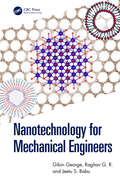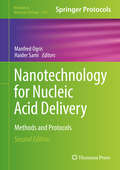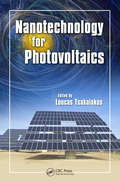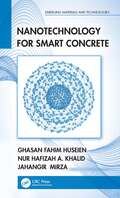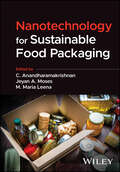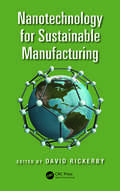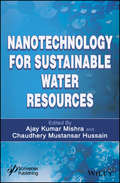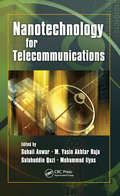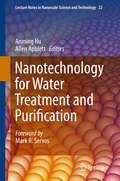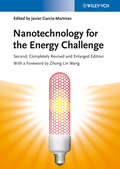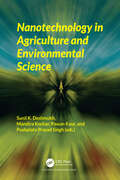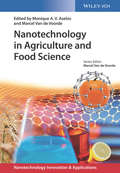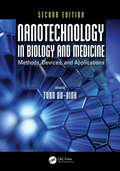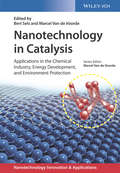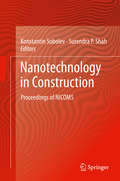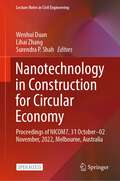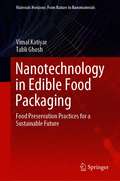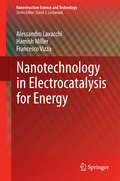- Table View
- List View
Nanotechnology for Infectious Diseases
by Saif Hameed Suriya RehmanThis book aims to cover the applications of nanotechnology against human infectious diseases. The chapters of the book discuss the role of nanotechnology in the efficient diagnosis and treatment of these diseases. It explicitly provides an overview of nanodiagnostics for infectious diseases from nanoparticles-based, nanodevice-based, and point-of-care platforms. The book also covers the state-of-the-art review of recent progress in biomimetic and bioengineered nanotherapies to treat infectious diseases. It also presents a nano carrier-based CRISPR/Cas9 delivery system for gene editing and its applications for developing interventional approaches against communicable diseases. Further, it reviews the recent developments in nanotechnology to engineer nanoparticles with desired physicochemical properties as a line of defense against multi-drug resistance micro-organisms. Cutting across the disciplines, this book serves as a guide for researchers in biotechnology, parasitology, and nanotechnology.
Nanotechnology for Light Pollution Reduction
by Ram K. Gupta Tuan Anh NguyenLight is essential for living organisms; however, excessive light causes adverse health conditions. This book covers the most recent progress on nanotechnology for reducing light pollution, discussing many approaches and technologies for controlling light pollution.The book explores the fundamentals of light and the causes of light pollution, delving into light pollution’s social, economic, and ecological impacts, its effects on living beings and the environment, as well as possible solutions and methods of control. The text discusses smart lighting technology, covering the various smart nanomaterials, nanosensors, and nanodevices involved. It also explores smart lighting involving natural light from the sun, artificial skydomes, shadow-free/secondary light sources, and the basics of many emerging devices such as light-emitting diodes and photosensors.Nanotechnology is key to providing a new route for the next generation of lighting devices and systems with reduced light pollution. This essential reference illuminates emerging technologies and their applications, providing new directions to scientists, researchers, and students to better understand the principles, technologies, and applications of nanotechnology in light pollution.
Nanotechnology for Lithium-Ion Batteries
by Isobel Davidson Yaser Abu-LebdehThis book combines two areas of intense interest: nanotechnology, and energy conversion and storage devices. In particular, Li-ion batteries have enjoyed conspicuous success in many consumer electronic devices and their projected use in vehicles that will revolutionize the way we travel in the near future. For many applications, Li-ion batteries are the battery of choice. This book consolidates the scattered developments in all areas of research related to nanotechnology and lithium ion batteries.
Nanotechnology for Mechanical Engineers
by Gibin George Raghav G. R. Jeetu S. BabuThis book exclusively aims to deliver a basic understanding of nanotechnology from a mechanical engineering perspective. It begins with the history and fundamentals of nanotechnology and comprehension of the relationship between the properties and the structure. A brief overview of the several techniques available for the synthesis of various nanostructures and the techniques for size control is provided in the subsequent section. Further, it demonstrates applications of nanostructured materials in the field that are closely related to mechanical engineering. Presents exclusive discussion and elaboration on the nanomaterials in varied aspects of mechanical engineering. Covers machining techniques for nanostructure manufacturing, such as chemical grinding and additive manufacturing. Discusses advanced synthesis techniques of nanostructures and nanomaterials. Illustrates computational techniques relevant to mechanical properties of nanomaterials. Includes smart materials in the military, automobile, and aerospace applications. This book is aimed at researchers and graduate students in mechanical engineering and nanotechnology.
Nanotechnology for Microfluidics
by Chunli Bai Minghua LiuThe book focuses on microfluidics with applications in nanotechnology. The first part summarizes the recent advances and achievements in the field of microfluidic technology, with emphasize on the the influence of nanotechnology. The second part introduces various applications of microfluidics in nanotechnology, such as drug delivery, tissue engineering and biomedical diagnosis.
Nanotechnology for Nucleic Acid Delivery
by David Oupicky Manfred OgrisNanotechnology and nucleic acid based therapies are two emerging fields in science whose combination has the potential to improve quality of life for patients suffering from various diseases that can so far only be treated in an unsatisfactory way. Nucleic acids offer the potential for highly selective treatment of such diseases or the highly specific modulation of gene expression with RNA interference. A key issue for successful nucleic acid therapies is the availability of a suitable delivery system. Here, the field of nanotechnology offers a multitude of possibilities to develop nanosized delivery vectors tailor-made for various local and systemic approaches. In Nanotechnology for Nucleic Acid Delivery: Methods and Protocols, experts in the field cover the area of nanoparticulate delivery of nucleic acids in terms of biosafety, particle synthesis as well as its application in cell culture. Written in the successful Methods in Molecular BiologyTM series format, chapters include introductions to their respective topics, lists of the necessary materials and reagents, step-by-step, readily reproducible protocols, and notes on troubleshooting and avoiding known pitfalls. Authoritative and easily accessible, Nanotechnology for Nucleic Acid Delivery: Methods and Protocols seeks to serve both professionals and novices with its well-honed methodologies.
Nanotechnology for Nucleic Acid Delivery: Methods and Protocols (Methods in Molecular Biology #1943)
by Manfred Ogris Haider SamiThis detailed second edition volume expands upon the prior edition by addressing newly emerged technologies as well as improved existing protocols in nucleic acid delivery via nanotechnology. The book addresses topics ranging from chemical synthesis of macromolecules and bioconjugates, novel and established nanoformulations, characterization of these nanoformulations for biophysical, biological and toxicological aspects, and also protocols dealing with application and imaging of such carrier systems in vivo. Written for the highly successful Methods in Molecular Biology series, chapters include introductions to their respective chapters, lists of the necessary materials and reagents, step-by-step, readily reproducible laboratory protocols, and tips on troubleshooting and avoiding known pitfalls. Authoritative and up-to-date, Nanotechnology for Nucleic Acid Delivery: Methods and Protocols, Second Edition serves as an ideal guide to researchers seeking to use this vital area of study in their own lab work or to progress knowledge within the field itself.
Nanotechnology for Photovoltaics
by Loucas TsakalakosCurrent concerns regarding greenhouse gas-related environmental effects, energy security, and the rising costs of fossil fuel-based energy has renewed interest in solar energy in general and photovotaics in particular. Exploring state-of-the-art developments from a practical point of view, Nanotechnology for Photovoltaics examines issues in increas
Nanotechnology for Smart Concrete (Emerging Materials and Technologies)
by Ghasan Fahim Huseien Nur Hafizah Khalid Jahangir MirzaNanomaterials can markedly improve the mechanical properties of concrete, as well as reduce the porosity and enhance the durability of concrete. The application of nanotechnology in concrete is still in its infancy. However, an ever-growing demand for ultra-high-performance concrete and recurring environmental pollution caused by ordinary Portland cement has encouraged engineers to exploit nanotechnology in the construction industry. Nanotechnology for Smart Concrete discusses the advantages and applications of nanomaterials in the concrete industry, including high-strength performance, microstructural improvement, self-healing, energy storage, and coatings. The book Analyses the linkage of concrete materials with nanomaterials and nanostructures Discusses the applications of nanomaterials in the concrete industry, including energy storage in green buildings, anti-corrosive coatings, and inhibiting pathogens and viruses Covers self-healing concrete Explores safety considerations, sustainability, and environmental impact of nanoconcrete Includes an appendix of solved questions This comprehensive and innovative text serves as a useful reference for upper-level undergraduate students, graduate students, and professionals in the fields of Civil and Construction Engineering, Materials Science and Engineering, and Nanomaterials. Dr. Ghasan Fahim Huseien is a research fellow at the Department of Building, School of Design and Environment, National University of Singapore, Singapore. He received his PhD degree from the University of Technology Malaysia in 2017. Dr. Huseien has over 5 years of Applied R&D and 10 years of experience in manufacturing smart materials for sustainable building and smart cities. He has expertise in Advanced Sustainable Construction Materials covering Civil Engineering, Environmental Sciences and Engineering. He has authored and co-authored 50+ publications and technical reports, 3 books, and 15 book chapters, and participated in 25 national and international conferences/workshops. He is a peer reviewer for several international journals as well as Master’s and PhD students. He is a member of the Concrete Society of Malaysia and the American Concrete Institute. Dr. Nur Hafizah Abd Khalid is a Senior Lecturer at the School of Civil Engineering, Universiti Teknologi, Malaysia (UTM), and is a research member of the Construction Material Research Group (CMRG). She is currently a Council Member of the Concrete Society Malaysia (CSM). She earned her Master’s degree on structure and materials in 2011 from the Universiti Teknologi Malaysia. She received a Young Women Scientist Award (representing Malaysia) in 2014 in South Korea by KWSE/APNN. She is currently appointed as an Inviting Researcher at Hunan University, China, funded under the Talented Young Scientist Program (TYSP). Her research interests focus on concrete structural systems, advanced concrete technology (green concrete technology and fibre reinforced concrete), civil engineering materials, polymer composites, and bio-composites. Professor Dr. Jahangir Mirza has over 35 years of Applied Research and Development (R&D) as well as teaching experience. He has expertise in Advanced Sustainable Construction Materials covering Civil Engineering, Environmental Sciences and Engineering, Chemistry, Earth Sciences, Geology, and Architecture departments. He has been a Senior Scientist at the Research Institute of Hydro-Quebec (IREQ), Montreal, Canada since 1985. He has been a Visiting Research Professor for the Environmental Engineering program at the University of Guelph in Ontario, Canada since 2018.
Nanotechnology for Sustainable Agriculture, Food and Environment
by Avnesh KumarNanotechnology has the potential to drastically transform the agri-food sector with its significant applications to improve agricultural productivity and the efficiency of agrochemicals. The food sector has benefitted from the inclusion of nanoparticles in food matrixes and the nanoencapsulation of nutraceuticals. Smart packaging materials designed with the help of nanotechnology have been used for increasing the shelf life of stored food products. Nanomaterials have been extensively used for the delivery of important agrochemicals to enhance their bioefficacy, prevent their degradation, and control their release. Various nanomaterials have been explored for remediation of arising environmental issues. Nanotechnology has also made a useful contribution to the utilization of huge agricultural and food wastes for production of valuable products. The existing and emerging applications of nanotechnology will contribute to environmental sustainability. Nanotechnology for Sustainable Agriculture, Food and Environment has been structured to provide a widespread coverage and up-to-date progress of nanotechnology and its applications in the agri-food sector and environmental remediation. Synthesis of value-added nanomaterials from agri-food wastes and their potential applications in environmental remediation have been explored. In addition, toxicity issues with nanomaterials have also been discussed. Features: 1) Elaborated information on the use of nanotechnology for sustainable agriculture 2) In-depth study about valorization of agri-food waste 3) An overview of applications of nanotechnology in environmental remediation 4) Toxicity analysis of nanotechnology-based products We aim to satisfy the need for a reference book for scientists, researchers, academicians and students in nanotechnology, agricultural, food, nutraceuticals, environmental and material sectors.
Nanotechnology for Sustainable Food Packaging
by C. Anandharamakrishnan Jeyan A. Moses M. Maria LeenaLatest techniques for the development of biodegradable food packaging casings with commentary on safety concerns and regulatory frameworks Nanotechnology for Sustainable Food Packaging covers the latest techniques and applications of nanotechnology, demonstrating capabilities to revolutionize the food packaging sector. This includes concepts of biodegradable food packaging, approaches to improve material functionality, robust sensing systems, and the scope of employing advanced analytical and computational approaches to support progress in the field. Throughout, the text focuses on the United Nations Sustainable Development Goals, including life cycle analysis, biodegradability, green practices, eco-friendliness, and sustainability. This book explores the major food packaging matrixes (polymers, edible films, and multilayers), different categories of advances (composites, active and intelligent packaging), labeling considerations, region- and country-specific regulatory frameworks, and safety concerns. Readers will also find a futuristic preview of this rapidly advancing field and an overview of lab-ready technologies with the potential for commercialization. Written by a team of highly qualified authors, Nanotechnology for Sustainable Food Packaging discusses sample topics including: Nanotechnology’s potential to improve the shelf life of food products, the chemistry and functionality of different materials based on merits and possible challengesSources, chemistry, and functionality of various bio-based sources and their usage as nanocomposites, and bio-based alternatives, drawbacks, and research trendsBioactive compounds in food packaging and their benefits, preparation methods, characterization approaches, delivery, and assessmentSurface modification approaches through sustainable physico-chemical approaches, and the development of flexible packaging materials suitable for specific requirements such as nonthermal processing Nanotechnology for Sustainable Food Packaging is an essential scientific and technological reference for scientists and R&D personnel who are interested in advancing food packaging technologies. The book is also valuable for students, researchers, and food industry professionals studying nanotechnology in food, food packaging, and food science and technology.
Nanotechnology for Sustainable Manufacturing
by David RickerbyNanomaterials have the potential to contribute to more sustainable manufacturing through cleaner, less wasteful production processes and can substitute conventional materials, leading to savings in raw materials and energy. This book provides an innovative perspective by establishing connections between the subject areas associated with nanotechnology and by bridging academic and industrial research. It also covers methods for assessing the sustainability of nanotechnology-based products and processes using life-cycle analysis, taking into account material and energy consumption during manufacture, use, and final disposal and/or recycling.
Nanotechnology for Sustainable Water Resources
by Ajay Kumar Mishra Prof. Chaudhery Mustansar HussainIn this book, we have summarized recent progresses due to novel nanomaterials for sustainable water resources. Book provides a summary of the state of the art knowledge to scientists, engineers and policy makers, about recent developments due to nanotechnology for sustainable water resources arena. The advances in sustainable water resources technologies in the context of modern society’s interests will be considered preferably which allow to identify grand challenges and directions for future research. The book contributors have been selected from all over the world and the essential functions of the nanotechnologies have presented rather than their anticipated applications. Moreover, up to date knowledge on economy, toxicity and regulation related to nanotechnology are presented in detail. In the end, role of nanotechnology for green and sustainable future has also been briefly debated.
Nanotechnology for Telecommunications
by Mohammad Ilyas Sohail Anwar M. Yasin Akhtar Raja Salahuddin QaziWith its unique promise to revolutionize science, engineering, technology, and other fields, nanotechnology continues to profoundly impact associated materials, components, and systems, particularly those used in telecommunications. These developments are leading to easier convergence of related technologies, massive storage data, compact storage devices, and higher-performance computing. Nanotechnology for Telecommunications presents vital technical scientific information to help readers grasp issues and challenges associated with nanoscale telecommunication system development and commercialization—and then avail themselves of the many opportunities to be gleaned. This book provides technical information and research ideas regarding the use of nanotechnology in telecommunications and information processing, reflecting the continuing trend toward the use of optoelectronics. Nanotech will eventually lead to a technology cluster that offers a complete range of functionalities for systems used in domains including information, energy, construction, environmental, and biomedical. Describing current and future developments that hold promise for significant innovations in telecommunications, this book is organized to provide a progressive understanding of topics including: Background information on nanoscience and nanotechnology Specific applications of nanotechnology in telecommunications Nanostructured optoelectronic materials MEMS, NEMS, and their applications in communication systems Quantum dot Cellular Automata (QCA) and its applications in telecommunication systems How nonohmic nonlinear behavior affects both digital and analog signal processing Concepts regarding quantum switching and its applications in quantum networks The scale of the physical systems that use nanoscale electronic devices is still large, and that presents serious challenges to the establishment of interconnections between nanoscale devices and the outside world. Also addressing consequent social implications of nanotech, this book reviews a broad range of the nano concepts and their influence on every aspect of telecommunications. It describes the different levels of interconnections in systems and details the standardized assembly process for a broad specrum of micro-, nano-, bio-, fiber-optic, and optoelectronic components and functions. This book is a powerful tool for understanding how to harness the power of nanotech through integration of materials, processes, devices, and applications.
Nanotechnology for Water Treatment and Purification
by Anming Hu Allen ApblettThis book describes the latest progress in the application of nanotechnology for water treatment and purification. Leaders in the field present both the fundamental science and a comprehensive overview of the diverse range of tools and technologies that have been developed in this critical area. Expert chapters present the unique physicochemical and surface properties of nanoparticles and the advantages that these provide for engineering applications that ensure a supply of safe drinking water for our growing population. Application areas include generating fresh water from seawater, preventing contamination of the environment and creating effective and efficient methods for remediation of polluted waters. The chapter authors are leading world-wide experts in the field with either academic or industrial experience, ensuring that this comprehensive volume presents the state-of-the-art in the integration of nanotechnology with water treatment and purification.
Nanotechnology for the Energy Challenge
by Zhong Lin Wang Javier García-MartínezWith the daunting energy challenges faced by Mankind in the 21st century, revolutionary new technologies will be the key to a clean, secure and sustainable energy future. Nanostructures often have surprising and very useful capabilities and are thus paving the way for new methodologies in almost every kind of industry.This exceptional monograph provides an overview of the subject, and presents the current state of the art with regard to different aspects of sustainable production, efficient storage and low-impact use of energy.Comprised of eighteen chapters, the book is divided in three thematic parts:Part I Sustainable Energy Production covers the main developments of nanotechnology in clean energy production and conversion, including photovoltaics, hydrogen production, thermal-electrical energy conversion and fuel cells.Part II Efficient Energy Storage is concerned with the potential use of nanomaterials in more efficient energy storage systems such as advanced batteries, supercapacitors and hydrogen storage.Part III Energy Sustainability shows how nanotechnology helps to use energy more efficiently, and the mitigation of impacts to the environment, with special emphasis on energy savings through green nanofabrication, advanced catalysis, nanostructured light-emitting and eletrochromic devices and CO2 capture by nanoporous materials .An essential addition to any bookshelf, it will be invaluable to a variety of research fields including materials science, chemical engineering, solid state, surface, industrial, and physical chemistry, as this is a subject that is very interdisciplinary.
Nanotechnology in Agriculture and Environmental Science
by Pawan Kaur Sunil K. Deshmukh Mandira Kochar Pushplata Prasad SinghThis book provides examples applications of nanotechnology in addressing problems and challenges in agriculture as well as environmental sciences and provides an overview of innovations in nanopesticides, nanofertilizers, bionanosensors and nano-based delivery system for improving different aspects of plant productivity including pre-harvest and post-harvest strategies as well detection of contaminants that could be useful for enhancing soil health. Recycling of agricultural waste to beneficial products using nanotechnologies; bionanosensors; fate of nanomaterials and the ecological consequences of their delivery into the environment; safety and nanotoxicity issues are other topics being dealt with in this book. Chapters have been written by internationally recognized researchers and experts with special reference to the innovations and latest developments in the mentioned areas of nanobiotechnology that have applications and commercial importance, especially for crop fields and post-harvest management. Despite the research and development used to promote the use of nanotechnology in agriculture and the environmental, knowledge gaps and uncertainties about how to fill the gaps are more prevalent than scientific certainties about the public health and environmental effects of nanomaterials. The book thus addresses the issue of toxicity of nanomaterials in agricultural nanotechnology products. The book will be useful for active researchers and scientists in the agricultural sector, academia as well as industry, including nanotechnologists, plant pathologists, agronomists, agrochemists, environmental technologists and all scientists working for sustainability in agriculture. The book will encourage future and active researchers and scientists in the agriculture sector, academia as well as industry.
Nanotechnology in Agriculture and Food Science
by Marcel Van de Voorde Monique A. AxelosA comprehensive overview of the current state of this highly relevant topic. An interdisciplinary team of researchers reports on the opportunities and challenges of nanotechnology in the agriculture and food sector, highlighting the scientific, technical, regulatory, safety, and societal impacts. They also discuss the perspectives for the future, and provide insights into ways of assuring safety so as to obtain confidence for the consumer, as well as an overview of the innovations and applications. Essential reading for materials and agricultural scientists, food chemists and technologists, as well as toxicologists and ecotoxicologists.
Nanotechnology in Biology and Medicine: Methods, Devices, and Applications, Second Edition
by Tuan Vo-DinhThe second edition of Nanotechnology in Biology and Medicine is intended to serve as an authoritative reference source for a broad audience involved in the research, teaching, learning, and practice of nanotechnology in life sciences. This technology, which is on the scale of molecules, has enabled the development of devices smaller and more efficient than anything currently available. To understand complex biological nanosystems at the cellular level, we urgently need to develop a next-generation nanotechnology tool kit. It is believed that the new advances in genetic engineering, genomics, proteomics, medicine, and biotechnology will depend on our mastering of nanotechnology in the coming decades. The integration of nanotechnology, material sciences, molecular biology, and medicine opens the possibility of detecting and manipulating atoms and molecules using nanodevices, which have the potential for a wide variety of biological research topics and medical uses at the cellular level. This book presents the most recent scientific and technological advances of nanotechnology for use in biology and medicine. Each chapter provides introductory material with an overview of the topic of interest; a description of methods, protocols, instrumentation, and applications; and a collection of published data with an extensive list of references for further details. The goal of this book is to provide a comprehensive overview of the most recent advances in instrumentation, methods, and applications in areas of nanobiotechnology, integrating interdisciplinary research and development of interest to scientists, engineers, manufacturers, teachers, and students.
Nanotechnology in Catalysis: Applications in the Chemical Industry, Energy Development, and Environment Protection
by Marcel Van de Voorde Bert SelsReflecting the R&D efforts in the field that have resulted in a plethora of novel applications over the past decade, this handbook gives a comprehensive overview of the tangible benefits of nanotechnology in catalysis. By bridging fundamental research and industrial development, it provides a unique perspective on this scientifically and economically important field. While the first three parts are devoted to preparation and characterization of nanocatalysts, the final three provide in-depth insights into their applications in the fine chemicals industry, the energy industry, and for environmental protection, with expert authors reporting on real-life applications that are on the brink of commercialization. Timely reading for catalytic chemists, materials scientists, chemists in industry, and process engineers.
Nanotechnology in Construction
by Konstantin Sobolev Surendra P. ShahNanotechnology has already demonstrated surprising potential for improving the performance of construction materials and many of these recent developments were facilitated by NICOM symposia. The NICOM5 proceedings will cover the emerging opportunities and future use of nanotechnology in construction and will illustrate the broad potential for application of nanotechnology to challenging problems involving materials and infrastructure.
Nanotechnology in Construction for Circular Economy: Proceedings of NICOM7, 31 October–02 November, 2022, Melbourne, Australia (Lecture Notes in Civil Engineering #356)
by Surendra P. Shah Lihai Zhang Wenhui DuanThis open access book covers emerging opportunities and future use of nanotechnology in construction, including deep advances in cement chemistry, nanotechnology, artificial intelligence, robotics, concrete technology, and extreme engineering (blast, impact and fire). The proceedings also presents sectorial interactions within the traditional construction industry supply chain, enabled by the dynamic partnership between international industry, government agencies, and universities. Nanotechnology has transformed the construction materials industry into an advanced manufacturing sector to address climate change and carbon neutrality challenges by delivering sustainable and resilient infrastructure assets. Hence, this book reports specific advances in nanoscience and nano-engineering, and their impacts on numerous novel construction materials including binders, additives, high-performance concrete materials, concrete structural systems, polymer composites, and pavement materials.
Nanotechnology in Dermatology
by Adam Friedman Steven Wang Adnan NasirNanotechnology in Dermatology is the first book of its kind to address all of the important and rapidly growing aspects of nanotechnology as it relates to dermatology. In the last few years there has been an explosion in research and development for products and devices related to nanotechnology, including numerous applications for consumers, physicians, patients, and industry. Applications are underway in medicine and dermatology for the early detection, diagnosis, and targeted therapy of disease, and nanodesigned materials and devices are expected to be faster, smaller, more powerful, more efficient, and more versatile than their traditional counterparts. Written by experts working in this exciting field, Nanotechnology in Dermatology specifically addresses nanotechnology in consumer skin care products, in the diagnosis of skin disease, in the treatment of skin disease, and the overall safety of nanotechnology. The book also discusses future trends of this ever-growing and changing field, providing dermatologists, pharmaceutical companies, and consumer cosmetics companies with a clear understanding of the advantages and challenges of nanotechnology today.
Nanotechnology in Edible Food Packaging: Food Preservation Practices for a Sustainable Future (Materials Horizons: From Nature to Nanomaterials)
by Vimal Katiyar Tabli GhoshThis volume delivers a systematic overview of nanotechnology in the development of edible food packaging with noteworthy characteristics for improved food quality. It covers current research trends, history outlines, and state of the global marketin combination with associated biomaterials and synthesis strategies. The contents detail the use of various emerging bionanostructured materials such as cellulose nanostructures, chitosan nanostructures, and more.It further deliberates an in-depth discussion on various synthesis strategies and routes for the development of edible food packaging in terms of utilizing various nanosystems such as polymeric nanocomposites, nanoencapsulation systems, nanoemulsion systems, and others.Further, it also discusses experimental practices for bionanostructured and edible packaging materials to check the effectivity in terms of offering enhanced shelf life of food products. It also touches upon the socio-techno challenges in-line with developing edible packaging materials using nanotechnology for high performance packaging application. The book is an excellent guide for both the academia and industry especially early career professionals in edible food packaging sectors for selecting proper biomaterial involvingbiofillers, modifiers, cross linkers, compatibilizers and others to enhance the property of edible food packaging for targeted features.^
Nanotechnology in Electrocatalysis for Energy
by Alessandro Lavacchi Hamish Miller Francesco VizzaThis book focuses on nanotechnology in electrocatalysis for energy applications. In particular the book covers nanostructured electrocatalysts for low temperature fuel cells, low temperature electrolyzers and electrochemical valorization. The function of this book is to provide an introduction to basic principles of electrocatalysis, together with a review of the main classes of materials and electrode architectures. This book will illustrate the basic ideas behind material design and provide an introductory sketch of current research focuses. The easy-to-follow three part book focuses on major formulas, concepts and philosophies. This book is ideal for professionals and researchers interested in the field of electrochemistry, renewable energy and electrocatalysis.



